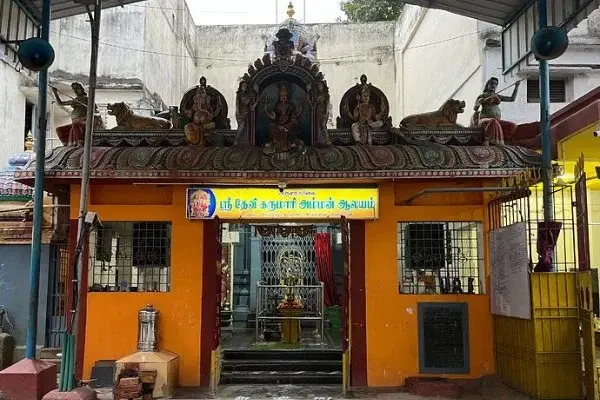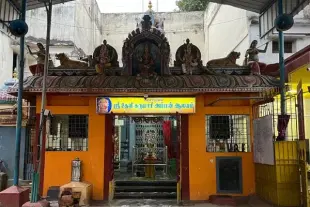Culture
When Aadi Mornings Fell Silent: Mourning The Loss Of Tamil Nadu's Temple Songs
K Balakumar
Jul 23, 2025, 02:42 PM | Updated 02:48 PM IST
Save & read from anywhere!
Bookmark stories for easy access on any device or the Swarajya app.


There was a time, not very long ago, when Tamil Nadu would awaken in Aadi (the Tamil month that runs from mid-July to mid-August) not to alarms or WhatsApp dings, but to something far more primal. To the fierce voice of L R Eswari, blaring from loudspeakers tethered to temples, calling upon the goddesses through rousing numbers like Karpoora Nayagiye or Chellatha.
They were less songs, more a morning invocation, a summoning of spirit, and almost a neighbourhood’s collective nudge into consciousness.
The voice of L. R. Eswari was not a soothing bhajan in, say, M. S. Subbulakshmi mould. It was power in pitch. She brought to the fore a grama devata energy, a raw, rustic Amman bhakti that belonged to the soil and the sweat of Tamil folk culture. They signalled ritual, season and memory.
Temples, mostly roadside ones, mounted rusted speakers atop their towers. Around 5 or 5:30 in the morning, someone inside pressed play on a music system running a scratchy vinyl record or cassette or CD. And then, the music spilled out, wrapped in static and sincerity. You could not avoid it, and most of you did not want to. It was a tradition that was loud, yes. But never empty. It roared with faith and fervour.
And today, they are mostly gone from the streets.
And Then, Silence
In cities like Chennai, Coimbatore or Madurai, a strange quietude now hangs over Aadi mornings. A silence filled only by car engines, phones buzzing, alarms beeping. The speakers that once clung to temple pillars with hopeful wires are missing, forbidden or discouraged by evolving noise pollution norms and an urban sensibility that demands muted mornings, ‘peaceful’ neighbourhoods, and a general shift towards more muffled expressions of religiosity in public spaces.
To be sure, this is no criticism, as change often comes wearing the cloak of necessity. City-dwellers deserve their tranquillity, and the laws that protect hearing or sanity are much needed. But the price paid is the loss of a quaint tradition and togetherness. What we seem to have lost is the ambient fabric of public faith, not religion as ideology, but religion as a shared rasa, a flavour of collective rhythm.
For those songs that emerged out of the temples were not just about music or about religion (a similar essay could be attempted for songs like this that billowed out of churches during Christmas times). They were community choreography.
One temple playing a song often triggered another. The whole neighbourhood soon fell into sync. Milk vendors, flower sellers, the early risers, all moved to the same tempo. Or so it seemed. This sonic culture created a street-corner sense of belonging. It stitched neighbours together. You knew what festival was coming by the songs you heard. You knew the month. You felt the calendar in your bones.
The Nostalgia We Are Denying Ourselves
The true richness of those temple songs was also never their high fidelity, but their ubiquity. You learned the tunes by osmosis, as you did not need to understand raga or shruti, you just needed to live nearby. There were hardly any houses whose members could not recite, if not by heart, then at least by muscle memory, the refrains of Mariamma Engal Mariamma or Kannapura Nayagiye.
In the communal listening that took place, sometimes grudgingly but often joyfully, Tamil society discovered not just religious comfort, but a storehouse of nostalgia for the future.
For older listeners, the first notes of Eswari’s Thaaye Karumaari crackling through a tiny, overdriven speaker can still conjure up their childhood in an instant: the wet smell of dusty tar road, the slow rising aroma and steam of sambar and idli from kitchen windows, and the gentle chaos of women hurrying with milk pots to the Amman temple, all moving to the same rhythm.
Today, the bhakti music tradition is not gone, merely shifted. Devotional songs are everywhere, on YouTube jukeboxes, in algorithmic playlists, inside earbuds that fit snugly and privately. They pour forth for Aadi Maasam, and every other occasion, and the sheer number of devotional albums, spanning myriad names and not just Eswari's, suggests the appetite remains fervent, albeit channelled differently.
What Rituals Gave Us
Yet the intimacy of a temple festival or the collective build-up to an Aadi velli (Aadi Friday) can never be wholly digitised. The digital bhakti experience, even if portable and infinitely customisable, is also solitary and atomised. In moving devotion from the street speaker to the smartphone, something vital gets lost. That unbidden encounter, the accidental chorus of a community that rarely paused to ask who arranged the playlist, or why.
It is not mere sentimentality to mourn this passing. Social psychology teaches us that rituals, especially musical and collective, are profound creators of social trust, happiness and identity. When you stand shoulder to shoulder in a festival throng, singing a song sung by your mother and heard by your children, you become larger than yourself. You inherit a rhythm that stretches backward and forward in time.
A tune, repeated every year for decades, could also become an emblem of 'us', that peculiar little ‘us’, the ones who happened to inhabit the same few hours before the day’s work began in a neighbourhood. In our hurried living, we often underestimate how much happiness resides in these memories made together. The sweet ache of common recall is a hallmark of happy community living.
And so, this is the real eulogy: not to Eswari’s Amman songs themselves, which remain immortal in their online avatars, but to the public life those tunes once shared. In their absence, the streets of Tamil Nadu have grown a little colder. All that remains is the hope that someone, somewhere, remembers the way it felt when the dawn belonged to everyone, and the first sound of an Aadi day was a blare, not from a screen, but from the heart of the neighbourhood itself.





